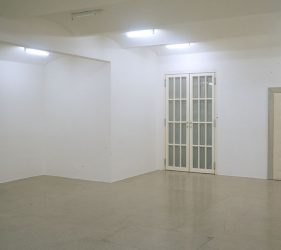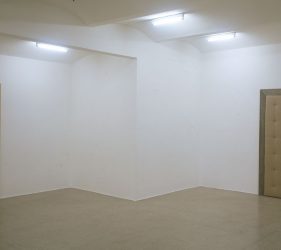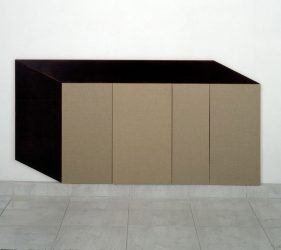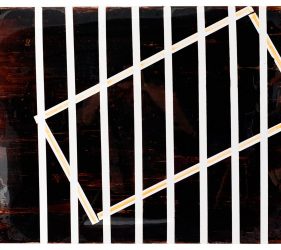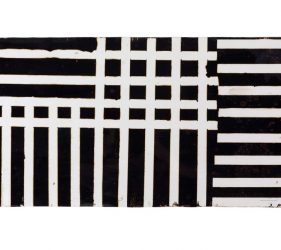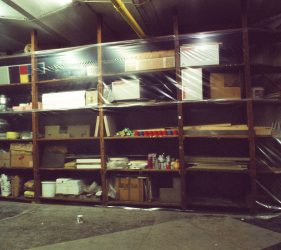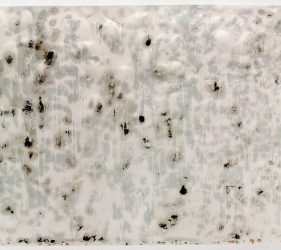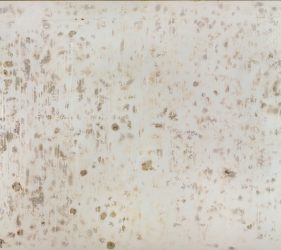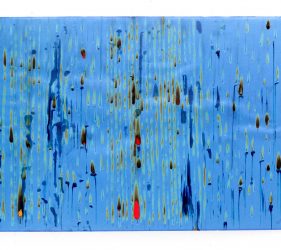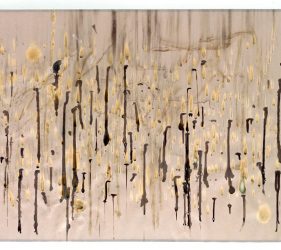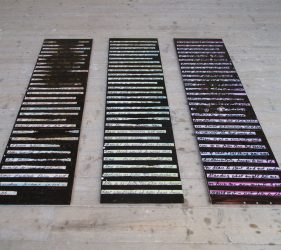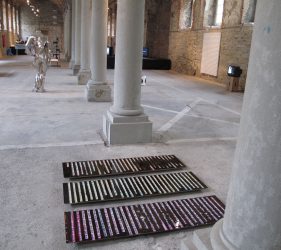Excerpt from the foreword to the catalogue Dimensions of the Surface:
Dimensions: Associations with the Work of Nita Tandon
[…] As I was sitting in Nita Tandon’s studio asking her about her work, I found myself sitting opposite one of her works: a door built into a wall. Just as this book documenting Nita Tandon’s work is called Dimensions of the Surface, the door in the wall corresponds to that title. The door consists solely of its own surface; it cannot be opened and, therefore, it cannot be closed. As an artwork it is ostentatiously factored out of the usual exploitations, and unfortunately that is true also with regard to any hermeneutic exploit-ations: the door in the wall neither invites you to express an opinion about it, nor does it prevent any measure of interpretation.
Ever since I began studying philosophy I have had something of a hermeneutic tick, a slight compulsion (whenever an opportunity arises) to interpret what is already visible. Take doors or bridges, for example. These are metaphors – and no minor ones at that; indeed, in dimensional terms they could not be greater: being able to step inside, being shut out … As the idiom goes, every door is an opening. And yet, occasionally, a door does stay closed.
Franz Kafka was a lawyer, and as a writer he is probably the most famous opponent of any form of wishful thinking about the law, which would have us believe that the law is open to everyone. As Kafka writes in one of his parables, ‘Before the law stands a door-keeper. A man from the country comes to this door-keeper and asks for entry into the law. But the door-keeper says he cannot grant him entry now. The man considers and then asks if that means he will be allowed to enter later. “It is possible,” says the door-keeper, “but not now.”’
This indication of time holds out the prospect of the man gaining admission at some point; it is a postponement to the future. It also means that the enquirer is referred to an activity which, by its very nature, is most strange in that it is based on passivity – that is, on waiting. I have in my possession a postcard featuring the likeness of [Bavarian comedian and cabaret performer] Karl Valentin and a quote by the comedian, a kindred spirit of Kafka’s. It reads, ‘At first I waited slowly, but then ever more quickly.’ Indeed, as time runs out, it becomes crucial to wait faster and faster. And the man in Kafka’s parable waited and waited, but there’s a limit to how much a man can wait – after all, his death comes ever closer. As a dying man, the character in Kafka’s tale Before the Law finally gets an inkling of the sort of question he might have to ask in order to find out what was happening to him: ‘“But everybody strives for the law,” says the man. “How is it that in all these years nobody except myself has asked for admittance?” The door-keeper realises the man has reached the end of his life and, to penetrate his imperfect hearing, he roars at him: “Nobody else could gain admittance here, this entrance was meant only for you. I shall now go and close it.”’ […]
A Trace Dismantled
A video showing scenes of a deinstallation, two small boxes with thousands of squares of Plasticine, each the same size, is all that remains of Nita Tandon’s Fingerprint – Die Rückseite der Vorderseite [The Back of the Front]. Is Fingerprint a performance, an installation? Is it an object, a picture, or a sculpture? This defiance of classification is in no way a disruptive factor; to the contrary, it is the very subject of this work: a game of identity for which the oversized fingerprint serves the artist as a motif.
The fingerprint, a pixelated scan in four shades of grey, is made by pressing eight-by-eight-centimetre squares of Plasticine with the finger onto the large glass facade of Schauraum, the exhibition space of the University of Applied Arts, in a passage of Vienna’s Museum Quarter. The space itself remained unused during the entire course of the exhibition. However, visitors were allowed to enter the space at the opening and had the opportunity to see the back of an oversized fingerprint, which in contrast to its two-dimensional front was three-dimensional. Once again Fingerprint defied classification. It was exhibited for several weeks on the glass pane, where passers-by could only view its two-dimensional
front. It was not always apparent even from close quarters that the material used was Plasticine. Finally, the Plasticine was removed and the glass pane thoroughly cleaned. That precisely the process of deinstallation – usually not deemed worthy of documentation – was recorded on film by Nita Tandon is yet another reversal that further underscores Fingerprint’s temporary character.
Fingerprint robs us of all terms of description, or Fingerprint forces us to choose a definition. Nita Tandon thus succeeds in creating a definition of the term ‘identity’ for which she uses methods that are not analytical but purely synthetic, playing a game with identity of which nothing remains but memories of
a documentation of the deinstallation of a fingerprint.
Daniel Wisser, 2011
Regal lautet der Titel dieser Arbeit, die Nita Tandons Beitrag zu einer von ihr kuratierten Gruppenausstellung war, die im Untergeschoß ihres Ateliers stattfand. Die Unzugänglichkeit von Raum und
zur Arbeit benötigtem Material während der Vorbereitungsphase und der gesamten Dauer der Ausstellung wurde zum Gegenstand dieser Arbeit. Tandon verstaute die Materialien, mit denen sie gearbeitet hatte, zusammen mit den unfertigen Werken in einem großen Regal, das im Ausstellungsraum eingebaut war, sodass das Kunstwerk und die Voraussetzungen für seine Produktion, Aufbewahrung und Archivierung in einem Objekt vereint waren.

